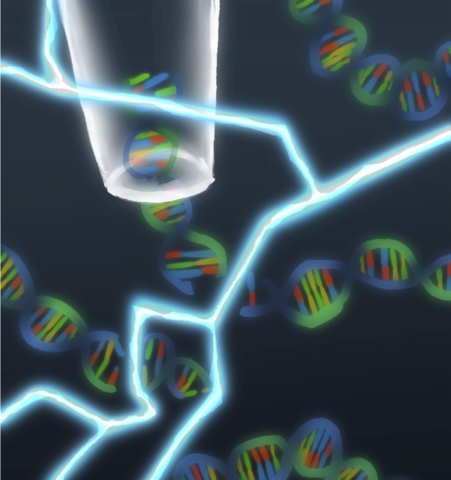
Inez Robertson/NIST
Scientists at the National Institute of Standards and Technology (NIST) have developed a new technology for measuring how radiation damages DNA molecules. This novel technique, which passes DNA through tiny openings called nanopores, detects radiation damage much faster and more accurately than existing methods. It could lead to improved radiation therapy for cancer and more personalized care for individuals during radiological emergencies.
"With nanopore sensing, we're not just measuring radiation damage; we're rewriting the rules on how quickly and effectively we can respond to both cancer care and emergencies," said NIST physical scientist Joseph Robertson.
The research has now successfully completed the proof-of-concept phase, having been demonstrated in the laboratory using carefully prepared DNA in a test tube. Future plans involve developing a portable version of the technology and utilizing the technique to measure radiation damage to DNA extracted from biological cells and tissues.
How the New Technology Works
Current methods for measuring the biological effects of radiation are slow and often ineffective at providing results when needed, particularly in medical and emergency situations. To assess radiation damage in an individual exposed to radiation, medical professionals take a blood sample and either count the number of dead cells (a process that takes at least two days) or culture cells from the sample to detect chromosomal abnormalities (which takes at least three days).
These existing techniques have a limited range and cannot measure doses above about 5 gray, which is lower than what an individual may be exposed to in a major radiological incident. A gray (Gy) is a unit that expresses the amount of radiation energy absorbed by the body or an object per kilogram of mass.
The new technique, published in Analytical Chemistry, is particularly effective for measuring doses between 2 Gy and 10 Gy - a crucial range of radiation exposure in humans that necessitates immediate medical care . It can produce results within minutes rather than days, with significantly higher accuracy than previously achievable.
The method leverages the fact that ionizing radiation, such as X-rays and gamma rays, breaks DNA into smaller fragments.
To demonstrate the new approach, researchers utilized radiation-damaged DNA samples . They passed the DNA fragments through a nanopore, which had an electric current flowing through it. DNA molecules that passed through the nanopore caused disruptions in the current. By monitoring these variations, the researchers could measure the number of DNA fragments transiting the nanopore and determine their lengths. This information allowed the researchers to accurately calculate the effective radiation dose that impacted the DNA.
Tailoring Therapies for Better Outcomes
In the quest to enhance cancer treatment, real-time monitoring of radiation exposure is essential.
"Too little radiation can fail to destroy cancer cells, while too much can harm healthy tissue," said Robertson. "The ability to monitor radiation exposure in real time means doctors can adjust treatments to ensure the right dosage."
This technology could also track how well a tumor is responding to radiation, allowing for personalized adjustments to treatment. By directly measuring DNA damage in cancer cells, doctors can tailor therapies more precisely to each patient.
Rapid Response in Emergencies
In radiological emergencies like nuclear accidents or radiation poisoning, the ability to quickly assess radiation exposure is crucial. Traditional methods may take days, but with this new technology, first responders can obtain real-time data in minutes.
"This would allow medical teams to quickly prioritize care for those most at risk," said Robertson.
NIST's breakthrough could transform responses to radiation emergencies and assist in saving lives by ensuring that individuals receive the appropriate care as quickly as possible.
A Commitment to Public Health and Safety
One of the key advantages of this technology is its potential portability. NIST researchers are collaborating with industry partners to develop a device that could be as small and affordable as a smartphone, making it easily accessible in hospitals, emergency response situations, and even field settings. In the coming years, researchers hope to partner with commercial entities to build a prototype device.
This technology not only signifies a substantial advance in measuring DNA damage but also underscores NIST's commitment to enhancing public health and safety through innovative science.
"This technology isn't merely a leap forward; it's a lifeline," said Robertson. "By making radiation measurement precise and accessible, we're striving to ensure that help is always within reach."
Paper: Michael Lamontagne, Shannon M. Newell, Ileana Pazos, Ronald Tosh, Jerimy Polf, Michael Zwolak and Joseph W.F. Robertson. Single-molecule biodosimetry. Analytical Chemistry. Published online Aug. 20, 2025. DOI: 10.1021/acs.analchem.5c03303






